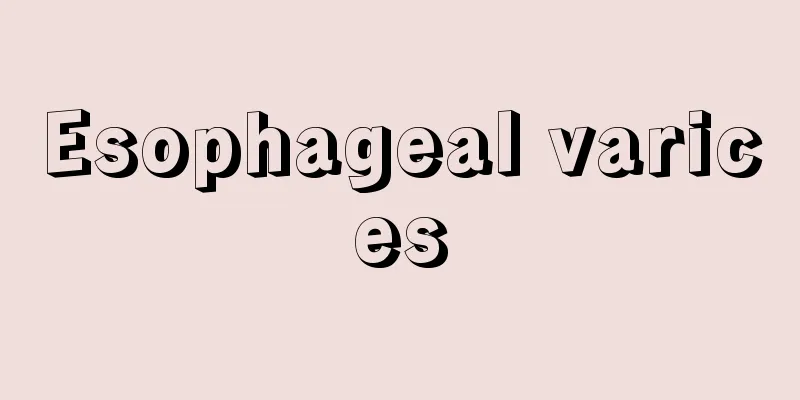Esophageal varices

|
Varicose veins occurring in the esophageal venous system are a severe symptom associated with portal hypertension due to circulatory disorders in the portal venous system. The venous plexus of the upper esophagus connects to the inferior vena cava via the azygos vein, and the venous plexus of the lower esophagus connects to the portal vein via the gastric vein. When portal vein pressure increases, the esophageal submucosal veins expand and become tortuous as a hepatic accessory circulation, forming esophageal varicose veins. In addition, local circulatory hyperactivity caused by the formation of arteriovenous shunts in the upper stomach also contributes to the formation of esophageal varicose veins. Diseases that cause esophageal varicose veins include liver cirrhosis, idiopathic portal hypertension, and Japanese schistosomiasis. According to a nationwide survey of portal hypertension cases with esophageal varicose veins conducted by the Japan Portal Hypertension Society from 1993 to 1996 (Heisei 5-8), 2139 out of 2242 cases (95.4%) were liver cirrhosis. [Teruo Kakegawa and Yukimitsu Kitagawa] SymptomsSymptoms include hematemesis and bloody stool, but the prognosis is poorer than other types of upper gastrointestinal bleeding, and it was previously thought that about half of patients died after the first episode. Diagnosis is mainly by esophagography and endoscopic examination. In recent years, some facilities have been using ultrasound endoscopy and 3D-CT (three-dimensional tomographic computed tomography scan) to obtain a detailed understanding of the hemodynamics of varices. Endoscopic examination is particularly important as an examination, and varices are classified according to their location, shape, and color. If red findings are observed in varices, it is considered a high risk of bleeding and caution is required. If esophageal varices develop into hematemesis and bloody stool, it is an emergency situation, and treatment for shock, such as securing blood vessels and administering oxygen, must be performed, and in some cases, endotracheal intubation must be performed without hesitation to prevent aspiration pneumonia and suffocation. [Teruo Kakegawa and Yukimitsu Kitagawa] TreatmentTreatments for esophageal varices are broadly divided into emergency hemostasis and elective preventive treatment. For emergency hemostasis, a treatment with high hemostatic effect should be selected, but as of 2009, the first choice is endoscopic hemostasis, with drug therapy and balloon compression therapy used as supplementary treatments. As for elective preventive treatment, endoscopic treatment also has good outcomes, and surgery is rarely chosen. Many patients with esophageal varices have a background of liver cirrhosis, so it is important to formulate an appropriate treatment plan taking into account factors such as hepatic reserve and the presence or absence of concurrent liver cancer. An overview of each treatment method is provided below. [Teruo Kakegawa and Yukimitsu Kitagawa] Drug therapyVasopressin has a strong vasoconstrictive effect, constricting splanchnic blood vessels and thus reducing portal vein pressure. Complications include angina pectoris, bradycardia, myocardial infarction, hypertension, and decreased urinary output, and administration is particularly contraindicated to patients with myocardial or renal disorders. Nitroglycerin reduces portal pressure by reducing vascular resistance in the intrahepatic and extrahepatic portal systems and by inducing reflex splanchnic vasoconstriction due to arterial vasodilation. Non-selective beta (beta) receptor antagonists reduce cardiac output through their beta 1 blocking action and reduce portal pressure by inhibiting vasodilation at the organ level through their beta 2 blocking action. [Teruo Kakegawa and Yukimitsu Kitagawa] Balloon compressionEsophageal varices are usually an ascending blood flow path formed from the varices in the cardia through the so-called splenic vessels at the esophagogastric junction. Therefore, hemostasis can be achieved by compressing the cardia or bleeding area with a balloon. A tube with a balloon called an SB tube (Sengstaken-Blakemore tube) is inserted transnasally into the stomach and the balloon is inflated. Currently, the first choice for esophageal variceal bleeding is endoscopic treatment, and the use of the SB tube has become less common, but it may be used in cases where a specialist skilled in endoscopic treatment is unavailable, when endoscopic visibility is poor due to massive bleeding, or as a treatment to relieve symptoms in patients with terminal liver cancer. [Teruo Kakegawa and Yukimitsu Kitagawa] Endoscopic treatment
(2) Endoscopic injection sclerotherapy (EIS) EIS is a treatment in which a sclerosing agent is injected endoscopically into the submucosa or blood vessels. It cannot be used in cases with low hepatic reserve, and in recent years, EVL, which is less invasive and provides more reliable hemostasis, has become widespread, so it is rarely used as the first choice. [Teruo Kakegawa and Yukimitsu Kitagawa] [References] | | | | | | |Source: Shogakukan Encyclopedia Nipponica About Encyclopedia Nipponica Information | Legend |
|
食道静脈系に発生した静脈瘤で、門脈系の循環障害に基づく門脈圧亢進(こうしん)症に伴う重篤な一症状である。上部食道の静脈叢(そう)は奇静脈を経て下大静脈へ、下部食道の静脈叢は胃静脈を経て門脈へ通じており、門脈圧が亢進すると遠肝性副血行路として食道粘膜下静脈の拡張や屈曲蛇行がおこり、食道静脈瘤を形成する。また、胃上部における動静脈シャント(短絡)形成などによる局所的循環亢進状態も食道静脈瘤形成に関与している。食道静脈瘤の原因疾患としては肝硬変、特発性門脈圧亢進症、日本住血吸虫症などがあげられるが、日本門脈圧亢進症学会による1993~1996年(平成5~8)のわが国の食道静脈瘤を有する門脈圧亢進症例の全国集計では2242例中、肝硬変症は2139例(95.4%)である。 [掛川暉夫・北川雄光] 症状症状としては吐血と下血であるが、他の上部消化管出血と比べてその予後は不良であり、以前は初回の出血で約半数が死亡するとされていた。診断としては食道造影と内視鏡検査が主体となる。近年では、静脈瘤の血行動態を詳細に把握する目的で、超音波内視鏡や3D-CT(三次元断層画像CTスキャン)を行っている施設もある。検査としては内視鏡検査がとくに重要であり、静脈瘤の位置や形態、色調による分類がなされるが、静脈瘤に赤色の所見が見られた場合、出血のリスクが高いとされており注意が必要である。食道静脈瘤が吐血・下血として発症した場合は緊急事態であり、血管確保や酸素投与などショックに対する治療を行い、場合によっては気管内挿管をためらわずに行い、誤嚥(ごえん)性肺炎や窒息をさける必要がある。 [掛川暉夫・北川雄光] 治療食道静脈瘤に対する治療は、緊急時の止血および待機的予防治療に大別される。緊急時の止血目的には止血効果の高い治療を選択するべきであるが、2009年の時点での第一選択は内視鏡的止血術であり、補助的に薬物療法やバルーン圧迫法が行われる。待機的予防治療に関しても、やはり内視鏡的治療の成績が良好であり、外科的手術が選択されることはほとんどない。食道静脈瘤を有する患者は肝硬変を背景にしていることが多く、肝予備能や肝癌(がん)の合併の有無などを考慮し適切な治療方針を立てることが重要である。以下に各治療法の概要を述べる。 [掛川暉夫・北川雄光] 薬物療法バソプレッシンは強力な血管収縮作用を有し、内臓血管を収縮させ、ひいては門脈圧を低下させる。合併症として狭心症、徐脈、心筋梗塞、高血圧、尿量低下があり、とくに心筋障害や腎障害を有する患者への投与は禁忌である。 ニトログリセリンは肝内外門脈系の血管抵抗性減弱と動脈系血管拡張による反射性内臓血管収縮により門脈圧を低下させる。 非選択的β(ベータ)受容体拮抗薬は、β1遮断作用による心拍出量低下とβ2遮断作用による臓器レベルでの血管拡張抑制による門脈圧低下作用を有する。 [掛川暉夫・北川雄光] バルーン圧迫法食道静脈瘤は通常、噴門部静脈瘤から食道胃接合部のいわゆるスダレ血管を経て形成される上行性の血流経路である。したがって噴門部あるいは出血部をバルーンにより圧迫することで、止血効果を得る。S-Bチューブ(Sengstaken-Blakemore tube)とよばれるバルーンの付いたチューブを経鼻的に胃内まで挿入し、バルーンを膨らませる。現在では食道静脈瘤出血の第一選択は内視鏡治療であり、S-Bチューブを用いる機会は少なくなったが、内視鏡治療に習熟した専門医が不在の場合や大量出血で内視鏡的に視野が不良の場合、また末期肝癌合併患者に症状緩和のための治療に用いられることがある。 [掛川暉夫・北川雄光] 内視鏡治療
(2)内視鏡的硬化療法(EIS:endoscopic injection sclerotherapy) EISは内視鏡的に硬化剤を粘膜下や血管内に注入する治療法である。肝予備能の低い症例では使用不可能であり、近年では侵襲が少なくより確実な止血が得られるEVLが普及しているため、第一選択として使用されることは少ない。 [掛川暉夫・北川雄光] [参照項目] | | | | | | | |出典 小学館 日本大百科全書(ニッポニカ)日本大百科全書(ニッポニカ)について 情報 | 凡例 |
Recommend
Zamba
...After World War II, under the influence of jaz...
Eragrostis lehmanniana (English spelling)
…[Tetsuo Koyama]. … *Some of the terminology that...
Congo-Kordofanian (English spelling)
The Congo-Kordofanian language group is the large...
Parent and Child Quality
... Looking at the genealogy of wealthy merchants...
Endogamy - endogamy
Intermarriage within a particular group or class, ...
Subarctic climate - akantaikikou
A cold climate unique to the subarctic zone. It i...
Shiki [city] - Shiki
A city in southeastern Saitama Prefecture. It was ...
Shoji Higashiura
Born: April 8, 1898 in Mie [Died] September 2, 194...
Shinzawa ruins
This is a Yayoi period ruin located in Higashitojo...
Oobatan (Oobatan) - red-crested cockatoo
A bird of the Psittacidae family (illustration). A...
Harlan, JR
...In 1966, Sasuke Nakao, in his book "The O...
Kresge, SS (English spelling) KresgeSS
…Headquarters: Troy, Michigan. The company was or...
Taisaku Kitahara
1906-1981 A Buraku liberation activist from the T...
Scabiosa - Scabiosa
A biennial plant of the family Diapathaceae (APG ...
international custom
…This refers to an external state action that is ...
![Iwata [city] - Iwata](/upload/images/67caf4ba4c0c4.webp)








